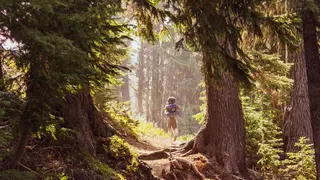
The world’s oldest known forest may offer valuable insights into the role that modern, purposefully regenerated forests play in the U.S., helping convert carbon dioxide into clean air and keeping deforestation at bay.
Located in New York state’s Catskill Mountains, the world’s oldest known forest doesn’t resemble a forest anymore—all that’s left of its ancient legacy are fossilized roots and ancient plants.
But research on it may help scientists figure out how trees began converting carbon dioxide into air some 386 million years ago, cooling a region that was south of the Earth’s equator at the time.
And that may offer valuable insight into the role that modern, purposefully regenerated woodlands play in shaping today’s climate and why deforestation is not an issue in North America.

What Is the Oldest Forest in the World?
The trees that grew in the Catskills during the Devonian Period, one segment of the roughly 280-million-year Paleozoic Era, bore little resemblance to the pine-filled woodlands there today. They looked more like palms, club mosses and horsetails and reproduced via microscopic spores, but they still absorbed carbon dioxide from the atmosphere, which led to the global cooling that marked the Paleozoic era, according to researchers at Binghamton University.
“It is no exaggeration to say that event was unique in Earth’s history and of highest importance to understanding how Earth’s systems interconnect,” William Stein, an emeritus professor of biological science at Binghamton, says in an article on the university’s website. Devonian ‘afforestation’, or the growth of trees where there was none, is essentially the reverse of the deforestation, burning fossil fuels and related increase in climate temperature happening today.
How Old and Young Forests Work Together
Historic and mature trees go limb-in-limb with young forests to ensure a sustainable ecosystem. Sustainably managed forests—for example, those that are maintained to support businesses such as papermaking—typically have areas of trees that are young, middle-aged and mature, which encourages a variety of sustainable wildlife habitats. Older forests foster some different types of flora and fauna, all of which come together to create a balanced planet.
Scientists also recognize that healthy forest management of all types of forests plays an important role in slowing the rise of global temperatures.
During the three decades from 1990 to 2021, U.S. woodlands were a net carbon sink, according to a report from the Congressional Research Service. In 2021 alone, forests removed a net 794 million metric tons of carbon dioxide from the atmosphere, the report shows.
That’s not just because of old forests or new forests, but how they play together. Old forests host more carbon dioxide than young forests. But the swift growth of young forests makes them more efficient at removing carbon dioxide from the atmosphere. In fact, working forests store carbon that’s equivalent to up to 15% of the United States’ annual carbon emissions.
By working with trained foresters to develop and maintain healthy purpose-grown woodlands, the paper and packaging industry is safeguarding not only the industry’s long-term security but that of the planet. Today’s U.S. forests grow nearly twice the tree volume that’s harvested every year.
What Is Afforestation, and How Does It Relate to Deforestation?
Both ancient forests and modern forests have made their contributions to afforestation, or the growth of trees in areas that haven’t had forests for decades. It happened in the Devonian era—and something similar is happening today with new, managed forests that are purposefully-planted for forestry products such as paper.
Contrast that with deforestation. The term doesn’t mean what you may think. Man-made deforestation refers to forests intentionally being destroyed and then converted to other land uses, such as agriculture or development.
While paper products come from trees, that doesn’t mean that the paper industry contributes to deforestation. In fact, the areas of the world that consume the most forestry products, including paper and packaging, have the least amount of deforestation. Not only does the forest products industry take seriously the commitment to responsible harvesting, but they also rely on a continuous and regenerating forest in close proximity to mills. It is not practical to deforest a location and then move a multi-billion-dollar manufacturing facility to a new location.



The paper industry isn’t tearing through public lands to stay afloat, either—90% of the wood used to make forestry products comes from private, sustainably managed working forests. When you choose those products, you help support these private landowners by providing a revenue stream to keep forestland forested and support a variety of forest stand improvements that result in healthy forest management and regeneration.
Sustainable forestry practices require long-term planning, with an eye toward growing a mix of trees of different ages—some measured in years, some in eras. By working to responsibly steward new forests, and carefully manage old ones, we work our way toward sustainable forestry for all.




